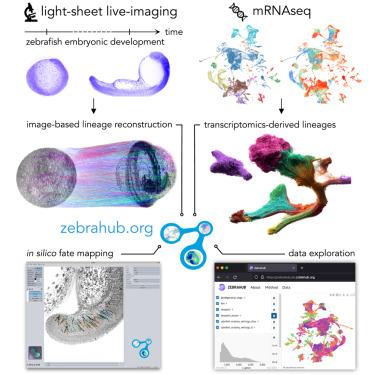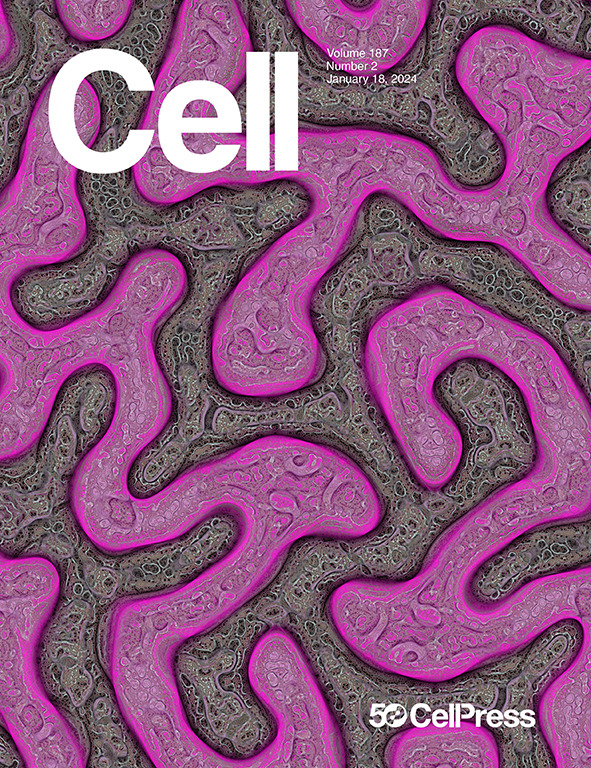多模态斑马鱼发育图谱揭示了晚期脊椎动物多能轴突祖细胞的状态转换动力学
IF 45.5
1区 生物学
Q1 BIOCHEMISTRY & MOLECULAR BIOLOGY
引用次数: 0
摘要
阐明生物体的发育过程需要全面了解细胞系的空间、时间和分子领域。在这项研究中,我们介绍了斑马鱼胚胎发育动态图谱 Zebrahub,该图谱将单细胞测序时程数据与光片显微镜帮助下的系谱重建结合在一起。该图集通过对十个发育阶段的单个胚胎进行测序,并辅以细胞轨迹重建,为斑马鱼的发育提供了高分辨率和深入的分子洞察。Zebrahub 还集成了一个交互式工具,用于浏览从光片显微镜数据中获得的复杂细胞流和细胞系,从而实现硅命运图谱实验。为了展示我们多模态资源的多功能性,我们利用 Zebrahub 对神经-中胚层祖细胞(NMPs)的多能性和肾脏-血管母细胞联合祖细胞群的起源提供了新的见解。本文章由计算机程序翻译,如有差异,请以英文原文为准。

A multimodal zebrafish developmental atlas reveals the state-transition dynamics of late-vertebrate pluripotent axial progenitors
Elucidating organismal developmental processes requires a comprehensive understanding of cellular lineages in the spatial, temporal, and molecular domains. In this study, we introduce Zebrahub, a dynamic atlas of zebrafish embryonic development that integrates single-cell sequencing time course data with lineage reconstructions facilitated by light-sheet microscopy. This atlas offers high-resolution and in-depth molecular insights into zebrafish development, achieved through the sequencing of individual embryos across ten developmental stages, complemented by reconstructions of cellular trajectories. Zebrahub also incorporates an interactive tool to navigate the complex cellular flows and lineages derived from light-sheet microscopy data, enabling in silico fate-mapping experiments. To demonstrate the versatility of our multimodal resource, we utilize Zebrahub to provide fresh insights into the pluripotency of neuro-mesodermal progenitors (NMPs) and the origins of a joint kidney-hemangioblast progenitor population.
求助全文
通过发布文献求助,成功后即可免费获取论文全文。
去求助
来源期刊

Cell
生物-生化与分子生物学
CiteScore
110.00
自引率
0.80%
发文量
396
审稿时长
2 months
期刊介绍:
Cells is an international, peer-reviewed, open access journal that focuses on cell biology, molecular biology, and biophysics. It is affiliated with several societies, including the Spanish Society for Biochemistry and Molecular Biology (SEBBM), Nordic Autophagy Society (NAS), Spanish Society of Hematology and Hemotherapy (SEHH), and Society for Regenerative Medicine (Russian Federation) (RPO).
The journal publishes research findings of significant importance in various areas of experimental biology, such as cell biology, molecular biology, neuroscience, immunology, virology, microbiology, cancer, human genetics, systems biology, signaling, and disease mechanisms and therapeutics. The primary criterion for considering papers is whether the results contribute to significant conceptual advances or raise thought-provoking questions and hypotheses related to interesting and important biological inquiries.
In addition to primary research articles presented in four formats, Cells also features review and opinion articles in its "leading edge" section, discussing recent research advancements and topics of interest to its wide readership.
 求助内容:
求助内容: 应助结果提醒方式:
应助结果提醒方式:


